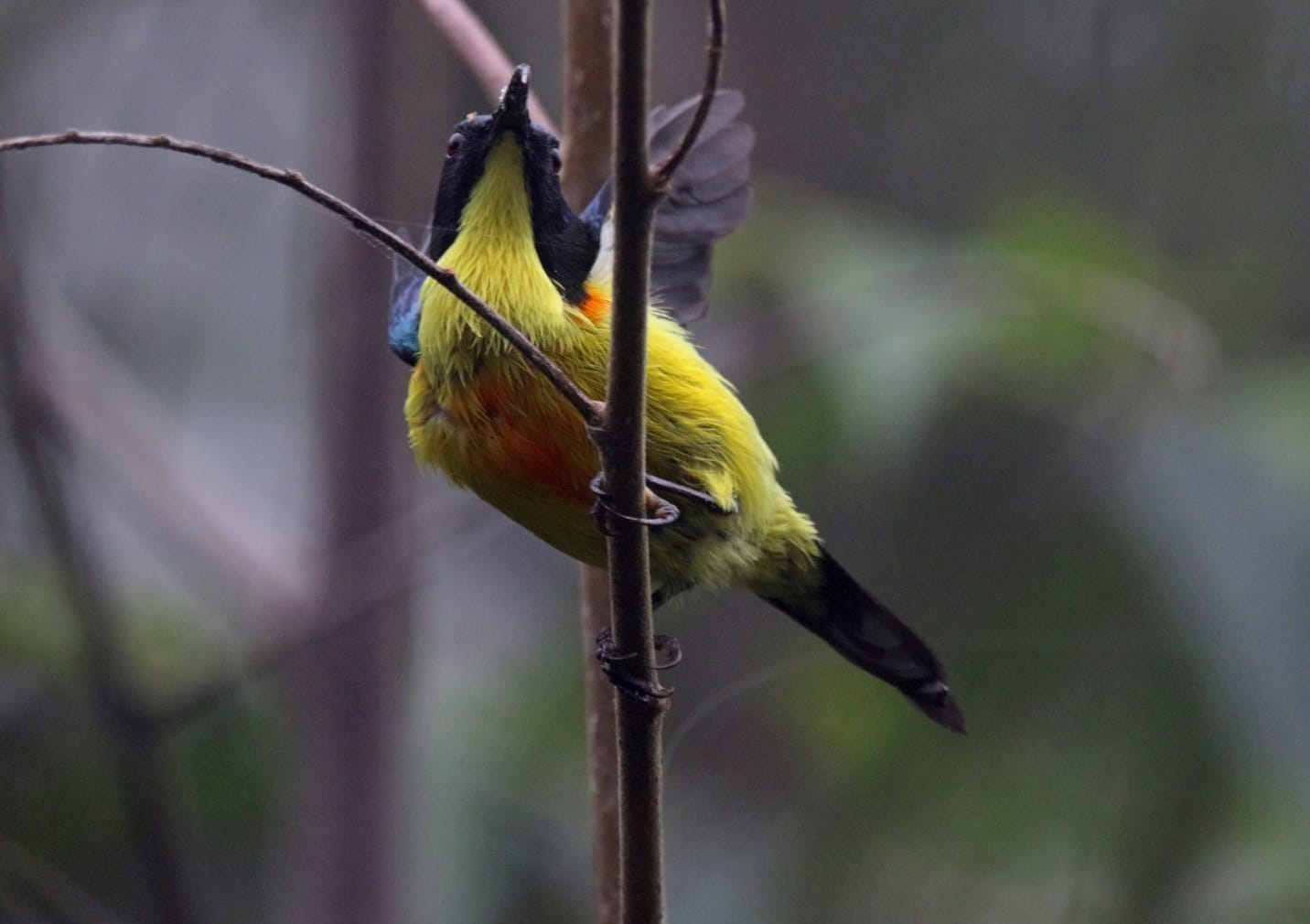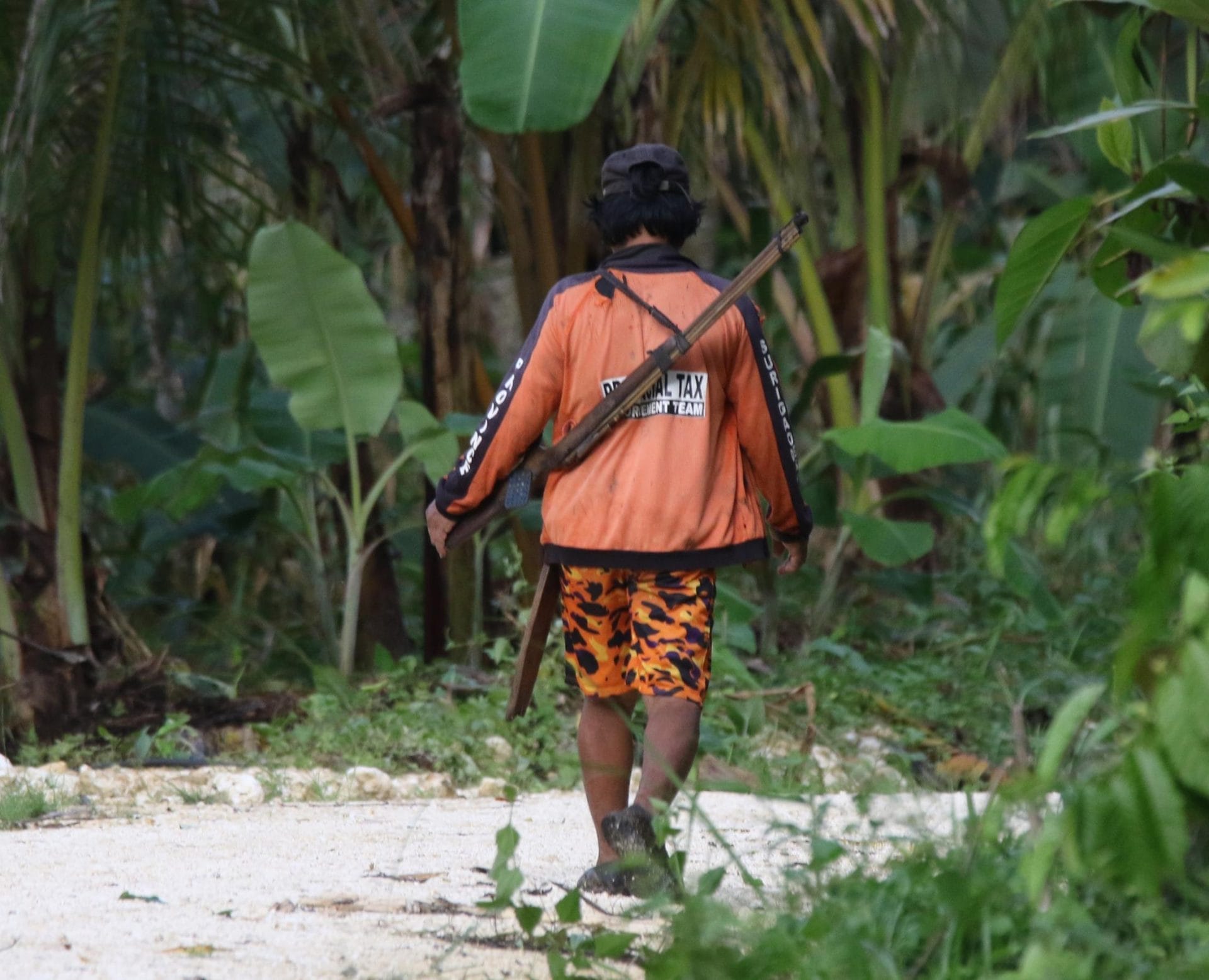Text and photos by Pete Simpson
This was a Wild Bird Club Philippines trip with three members from Manila (Willem van de Ven, Janjaap Brinkman, and Nikki Dyanne Realubit) and one from Thailand (Gawin Chutima). It was a condensed version of my previous tour, Mt Talomo from Davao, to ComVal via Panabo and PICOP ending with an airport drop back in Davao. All that in 5 days.
Mt Talomo delivered wonderfully. Four Japanese Night Heron reported on the first morning and one watched feeding in great light the following morning. These are an endangered species, rare and very difficult to see. We are lucky that they choose to spend the winter in the Davao area, and I try to ensure that they are not disturbed by my visits. They are a shy and cryptic bird that stick to the shadows and I confess that in the early days they would sometimes only be located when flushed. With more knowledge of their habits we are able to locate and observe the birds from a safe distance, they are aware but appear not concerned by our presence. The land owners and managers had been aware of these birds before birdwatchers knew, though they didn’t know the species or significance. Thankfully in this farmed area that the birds have chosen to spend the winter they are protected. My fear is that if disturbed from this site they would relocate and be eaten.

Whiskered Flowerpecker was seen briefly but in good light that first afternoon, followed by a fine display from a pair of Cryptic Flycatcher. While searching for those Cryptic Flycatcher we stumbled across Southern Silvery Kingfisher perched on the rocks of a mountain stream. Bonus sighting for the day was to have both forms of Purple-throated Sunbird on the same flowering tree. Davao is at the border between the red bellied and widely distributed ssp tricolous form and the yellow bellied central to west Mindanao and Sulu only ssp juliea form, the latter split already by HBW as Orange-lined Sunbird. In contrast to my previous tour the owling started well with instant response from Everett’s Scops Owl.
After second helpings of Japanese Night Heron the following morning, and multiple helpings at the buffet breakfast, we headed to Panabo where the Chinese Crested Tern behaved as they should, two birds (possibly four percent of the remaining world population) at high tide perched atop their favorite bamboo poles.

We had a short time at ComVal on day two, arriving from Panabo in the late afternoon to fog and the threat of rain. Lina’s Sunbird was difficult and I feared a washout, but a small flock of Mindanao Lorikeet saved the session.


The following morning we were up on site before dawn. Bukidnon Woodcock flew over roding a few times and Mindanao Scops Owl came close but remained hidden. We were hopeful of a clear dry morning and disappointed when the fog rolled in before 6am. Thankfully the discovery of a nearby fruiting bush means our short time on site was not wasted. Red-eared Parrotfinch was the bird that led us to the bush but once there we watched as mixed flocks moved through; Olive-backed Flowerpecker, Cinnamon Ibon and Rufous-headed Tailorbird passed and then Linas Sunbird visiting a flowering vine. After an hour Flame-crowned Flowerpecker joined the action. Winter visitors were in evidence here too with Mugimaki Flycatcher and two Olive-backed Pipits.
I did add another species to the already impressive ComVal site list, a surprising but not positive addition. Here at 1400masl the only starling should be Short-tailed Starling. Asian Glossy Starling are usually only up to 1200masl with Short-tailed coming in above 1000masl, meaning the overlap is should be only 1000-1200masl. At that altitude on Mt Talomo I have seen them mixed flock. We found two immature Asian Glossy sitting with a flock of Short-tailed, a new site record and possibly a further indication that the trashed habitat is attracting more trash birds.

From ComVal we continued east to Bislig for two days in PICOP, and as is customary upon arrival, we checked out Bislig airfield. But before that we had time for a quick look at Lake 77, previously a haven for resident and wintering ducks. Today there were none, I fear all were trapped for the cooking pot. Another wet birding session at the airfield with no chance of Grass Owl, but we did see both resident duck species and hear many Middendorff’s Grasshopper Warbler.

We suffered the authentic PICOP experience the following morning, the uncomfortable early jeepney ride to road 42. The owling was as it had been the previous week, frustratingly quiet. That frustration continued into our daytime birding, road 42 seems to have lost its mixed flocks. We walked almost to the end where just one of the group was treated to close views of two Mindanao Wattled Broadbill, the birds making their way silently back in to the forest before the rest of us arrived. We did see birds, Black-bibbed Cuckooshrike perched for scope views, Mindanao Blue fantail and Rufous Paradise Flycatcher were new for most, Philippine Leaf Warbler remain responsive and we managed all four species of Bulbul. The following day at the cemetery on road 4 we suffered an equally fruitless owling session, just a roosting Philippine Serpent Eagle in the spotlight. It was a tough morning attempting to salvage a half presentable PICOP list but the highlights were an early Rufous-lored Kingfisher, a lone Writhed Hornbill and great views of Striated Wren-Babbler. PICOP has less than one month to get its act together or there will be a lot of disappointed tour groups at the start of 2019.

On our way back to Davao we stopped again at Panabo to confirm that the CCTs have changed their habits since last winter, their absence on this day showing they must have new unknown bamboo pole to sit on at high tide.
This was probably a little more hardcore than the average WBCP trip, but I suspect we saw a lot more endemics and rare winter visitors than the usual fare.

It was another tough tour, and a short one considering the area we covered, but we managed 149 species including heard only, of which 77 are Philippine endemics by mixed taxonomy.
1 Wandering Whistling Duck (Dendrocygna arcuata)
2 Philippine Duck (Anas luzonica)
3 King Quail (Synoicus chinensis)
4 Red Junglefowl (Gallus gallus)
5 Spotted Dove (Streptopelia chinensis)
6 Philippine Cuckoo-Dove (Macropygia tenuirostris)
7 Zebra Dove (Geopelia striata)
8 White-eared Brown Dove (Phapitreron leucotis)
9 Amethyst Brown Dove (Phapitreron amethystinus)
10 Mindanao Brown Dove (Phapitreron brunneiceps)
11 Philippine Green Pigeon (Treron axillaris)
12 Pink-bellied Imperial Pigeon (Ducula poliocephala)
13 Green Imperial Pigeon (Ducula aenea)
14 Black-faced Coucal (Centropus melanops)
15 Philippine Coucal (Centropus viridis)
16 Violet Cuckoo (Chrysococcyx xanthorhynchus)
17 Plaintive Cuckoo (Cacomantis merulinus)
18 Rusty-breasted Cuckoo (Cacomantis variolosus)
19 Philippine Drongo-Cuckoo (Surniculus velutinus)
20 Great Eared Nightjar (Lyncornis macrotis)
21 Philippine Spine-tailed Swift (Mearnsia picina)
22 Pygmy Swiftlet (Collocalia troglodytes)
23 Ridgetop Swiftlet (Collocalia isonota)
24 Ameline Swiftlet (Aerodramus amelis)
25 Barred Rail (Gallirallus torquatus)
26 Plain Bush-hen (Amaurornis olivacea)
27 White-browed Crake (Amaurornis cinerea)
28 Pied Stilt (Himantopus leucocephalus)
29 Bukidnon Woodcock (Scolopax bukidnonensis)
30 Black-headed Gull (Chroicocephalus ridibundus)
31 Little Tern (Sternula albifrons)
32 Gull-billed Tern (Gelochelidon nilotica)
33 Whiskered Tern (Chlidonias hybrida)
34 Chinese Crested Tern (Thalasseus bernsteini)
35 Yellow Bittern (Ixobrychus sinensis)
36 Purple Heron (Ardea purpurea)
37 Great Egret (Ardea alba)
38 Little Egret (Egretta garzetta)
39 Pacific Reef Heron (Egretta sacra)
40 Western/Eastern Cattle Egret (Bubulcus ibis)
41 Javan Pond Heron (Ardeola speciosa)
42 Striated Heron (Butorides striata)
43 Japanese Night Heron (Gorsachius goisagi)
44 Western/Eastern Osprey (Pandion haliaetus)
45 Black-winged Kite (Elanus caeruleus)
46 Philippine Serpent Eagle (Spilornis holospilus)
47 Grey-faced Buzzard (Butastur indicus)
48 Crested Goshawk (Accipiter trivirgatus)
49 Brahminy Kite (Haliastur indus)
50 Everett’s Scops Owl (Otus everetti)
51 Mindanao Scops Owl (Otus mirus)
52 Philippine Trogon (Harpactes ardens)
53 Rufous Hornbill (Buceros hydrocorax)
54 Writhed Hornbill (Rhabdotorrhinus leucocephalus)
55 Mindanao Hornbill (Penelopides affinis)
56 Southern Silvery Kingfisher (Ceyx argentatus)
57 Philippine Dwarf Kingfisher (Ceyx melanurus)
58 White-throated Kingfisher (Halcyon gularis)
59 Rufous-lored Kingfisher (Todiramphus winchelli)
60 Collared Kingfisher (Todiramphus chloris)
61 Blue-capped Wood Kingfisher (Actenoides hombroni)
62 Oriental Dollarbird (Eurystomus orientalis)
63 Coppersmith Barbet (Psilopogon haemacephalus)
64 Philippine Pygmy Woodpecker (Yungipicus maculatus)
65 Buff-spotted Flameback (Chrysocolaptes lucidus)
66 Philippine Falconet (Microhierax erythrogenys)
67 Mindanao Lorikeet (Trichoglossus johnstoniae)
68 Mindanao Racket-tail (Prioniturus waterstradti)
69 Guaiabero (Bolbopsittacus lunulatus)
70 Philippine Hanging Parrot/Colasisi (Loriculus philippensis)
71 Wattled Broadbill (Eurylaimus steerii)
72 Azure-breasted Pitta (Pitta steerii)
73 White-breasted Woodswallow (Artamus leucorynchus)
74 Scarlet Minivet (Pericrocotus speciosus)
75 McGregor’s Cuckooshrike (Malindangia mcgregori)
76 Black-and-white Triller (Lalage melanoleuca)
77 Black-bibbed Cuckooshrike (Edolisoma mindanense)
78 Yellow-bellied Whistler (Pachycephala philippinensis)
79 Brown Shrike (Lanius cristatus)
80 Philippine Oriole (Oriolus steerii)
81 Black-naped Oriole (Oriolus chinensis)
82 Hair-crested Drongo (Dicrurus hottentottus)
83 Mindanao Blue Fantail (Rhipidura superciliaris)
84 Short-crested Monarch (Hypothymis helenae)
85 Black-naped Monarch (Hypothymis azurea)
86 Rufous Paradise Flycatcher (Terpsiphone cinnamomea)
87 Large-billed Crow (Corvus macrorhynchos)
88 Barn Swallow (Hirundo rustica)
89 Sulphur-billed Nuthatch (Sitta oenochlamys)
90 Yellow-wattled Bulbul (Brachypodius urostictus)
91 Yellow-vented Bulbul (Pycnonotus goiavier)
92 Yellowish Bulbul (Hypsipetes everetti)
93 Philippine Bulbul (Hypsipetes philippinus)
94 Rufous-headed Tailorbird (Phyllergates heterolaemus)
95 Philippine Leaf Warbler (Phylloscopus olivaceus)
96 Arctic Warbler (Phylloscopus borealis)
97 Mountain/Negros Leaf Warbler (Phylloscopus trivirgatus)
98 Clamorous Reed Warbler (Acrocephalus stentoreus)
99 Tawny Grassbird (Megalurus timoriensis)
100 Striated Grassbird (Megalurus palustris)
101 Middendorff’s Grasshopper Warbler (Locustella ochotensis)
102 Long-tailed Bush Warbler (Locustella caudata)
103 Rufous-fronted Tailorbird (Orthotomus frontalis)
104 Black-headed Tailorbird (Orthotomus nigriceps)
105 Mindanao White-eye (Lophozosterops goodfellowi)
106 Mindanao Pygmy Babbler (Dasycrotapha plateni)
107 Mountain White-eye (Zosterops montanus)
108 Brown Tit-Babbler (Macronus striaticeps)
109 Striated Wren-Babbler (Ptilocichla mindanensis)
110 Grey-streaked Flycatcher (Muscicapa griseisticta)
111 Rufous-tailed Jungle Flycatcher (Cyornis ruficauda)
112 Turquoise Flycatcher (Eumyias panayensis)
113 Bagobo Babbler (Leonardina woodi)
114 White-browed Shortwing (Brachypteryx montana)
115 Mugimaki Flycatcher (Ficedula mugimaki)
116 Little Pied Flycatcher (Ficedula westermanni)
117 Cryptic Flycatcher (Ficedula crypta)
118 Blue Rock Thrush (Monticola solitarius)
119 Pied Bush Chat (Saxicola caprata)
120 Eyebrowed Thrush (Turdus obscurus)
121 Island Thrush (Turdus poliocephalus)
122 Stripe-headed Rhabdornis (Rhabdornis mystacalis)
123 Asian Glossy Starling (Aplonis panayensis)
124 Short-tailed Starling (Aplonis minor)
125 Coleto (Sarcops calvus)
126 Philippine Leafbird (Chloropsis flavipennis)
127 Olive-backed Flowerpecker (Prionochilus olivaceus)
128 Whiskered Flowerpecker (Dicaeum proprium)
129 Olive-capped Flowerpecker (Dicaeum nigrilore)
130 Flame-crowned Flowerpecker (Dicaeum anthonyi)
131 Bicolored Flowerpecker (Dicaeum bicolor)
132 Red-keeled Flowerpecker (Dicaeum australe)
133 Orange-bellied Flowerpecker (Dicaeum trigonostigma)
134 Buzzing Flowerpecker (Dicaeum hypoleucum)
135 Purple-throated Sunbird (Leptocoma sperata)
136 Olive-backed Sunbird (Cinnyris jugularis)
137 Handsome Sunbird (Aethopyga bella)
138 Metallic-winged Sunbird (Aethopyga pulcherrima)
139 Lina’s Sunbird (Aethopyga linaraborae)
140 Orange-tufted Spiderhunter (Arachnothera flammifera)
141 Naked-faced Spiderhunter (Arachnothera clarae)
142 Grey Wagtail (Motacilla cinerea)
143 Paddyfield Pipit (Anthus rufulus)
144 Olive-backed Pipit (Anthus hodgsoni)
145 Cinnamon Ibon (Hypocryptadius cinnamomeus)
146 Eurasian Tree Sparrow (Passer montanus)
147 Red-eared Parrotfinch (Erythrura coloria)
148 White-bellied Munia (Lonchura leucogastra)
149 Chestnut Munia (Lonchura atricapilla)






Pingback:Behind the Guide: Zardo of PICOP – Wild Bird Club of the Philippines